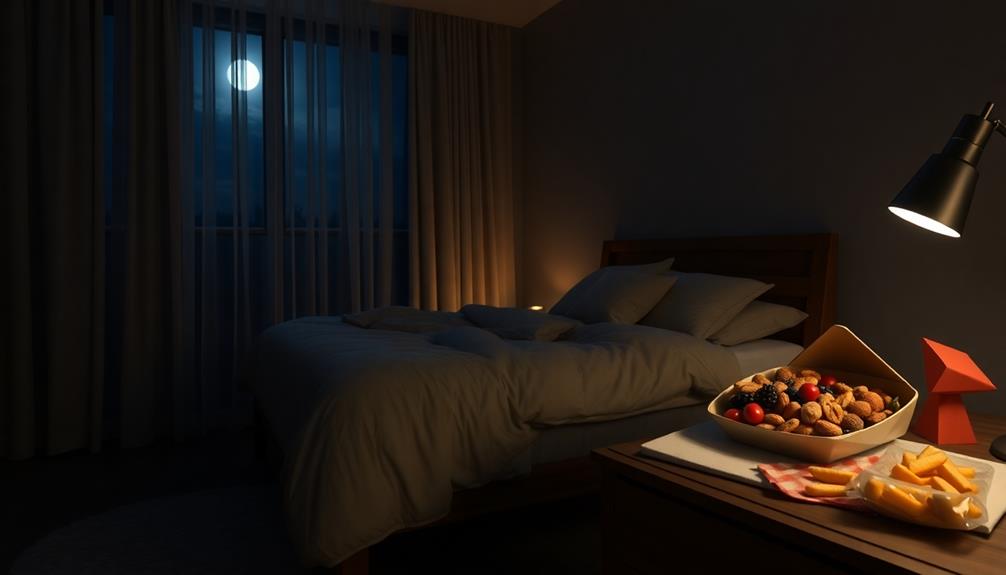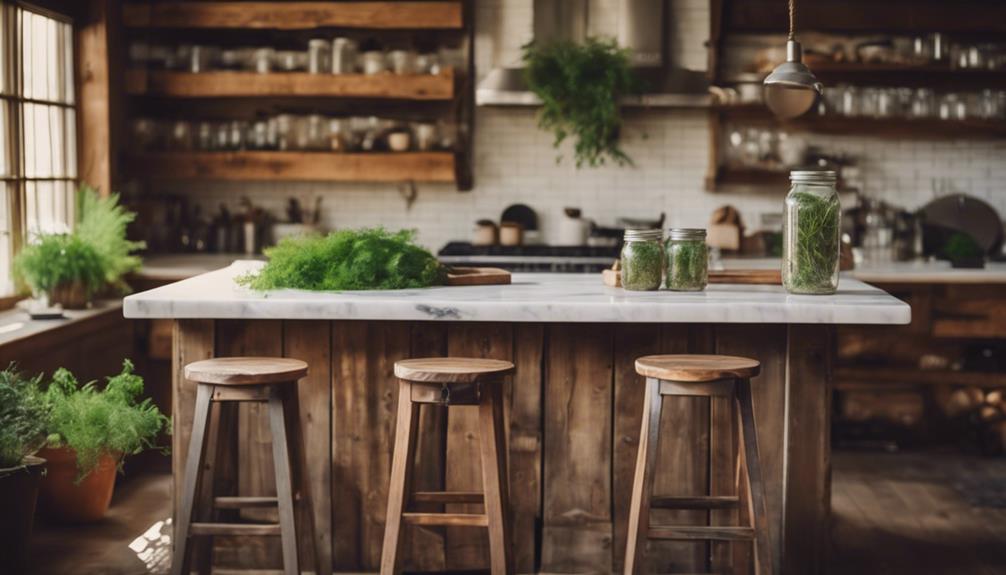Your eating habits are crucial in determining your dream patterns. Eating heavy or spicy meals before bedtime can negatively impact your sleep quality, leading to more intense and possibly disturbing dreams. Conversely, consuming lighter meals that aid in digestion can improve your sleep and result in more vivid and pleasant dreams. Some individuals may experience nightmares from consuming dairy products, while fasting may enhance dream clarity. Understanding how various foods influence your sleep and dreams can assist you in making healthier choices. There is still more to discover about this intriguing connection.
Key Takeaways
- Eating heavy or spicy meals close to bedtime disrupts sleep quality and leads to more vivid and disturbing dream patterns.
- Dairy products are commonly associated with nightmares, with 39-44% of college students reporting negative dream experiences linked to dairy consumption.
- Fasting or consuming lighter meals before bed can enhance dream clarity and intensity, promoting more enjoyable dream experiences.
- Foods high in fat can complicate dream patterns, while balanced diets correlate with more vivid and enjoyable dreams.
- Individual food sensitivities significantly affect sleep quality, impacting overall dream recall and experiences during sleep.
Connection Between Food and Dreams

Many people notice a captivating connection between what they eat and the dreams they experience at night. Your eating habits can greatly impact the nature of your dreams. For instance, studies reveal that many individuals, particularly college students, believe certain foods influence their dream patterns.
A considerable number of participants link dairy products to disturbing dreams, attributing negative experiences to their consumption. Curiously, foods rich in fat, like Red-Braised Pork Belly, may also contribute to heavier dreams due to their rich and complex flavors. If you've ever indulged in heavy or spicy foods before bed, you might've noticed that they disrupt your sleep quality and lead to more intense or vivid dreams.
Surprisingly, healthier diets and longer fasting periods seem to correlate with more vivid dreams. You might find it thought-provoking that historical beliefs also recognized fasting as a way to enhance dream experiences. This suggests that what you eat—or don't eat—can shape the quality of your dreams.
If you're seeking to improve your dream life, consider adjusting your diet. Reducing spicy foods and managing your eating habits before bedtime could help you achieve more peaceful sleep and, hopefully, fewer disturbing dreams. Understanding this connection can empower you to make choices that enhance your nightly escapades.
Impact of Food on Sleep Quality

When you eat large meals close to bedtime, you might find your sleep disrupted by discomfort.
Incorporating lighter, seasonal dishes like Nettle and Potato Soup or a revitalizing Grilled Peach and Burrata Salad can promote better digestion and enhance your sleep experience.
Your body's sensitivity to certain foods can also play a role in how well you rest at night.
Meal Timing Effects
The connection between meal timing and sleep quality is essential for anyone seeking restorative rest. Eating large meals close to bedtime can disrupt your sleep patterns as your body struggles with digestion, leading to poor sleep quality. Late-night eating not only increases brain activity during sleep, enhancing dream recall, but also contributes to disturbed sleep. To improve your rest, consider consuming smaller, lighter meals before bed.
Here's a quick comparison of meal timing effects:
| Meal Timing | Effects on Sleep Quality |
|---|---|
| Large meal before bed | Disrupted sleep, poor REM sleep |
| Late-night eating | Increased brain activity, vivid dreams |
| Lighter meal before bed | Better sleep, less vivid dreams |
| Longer fasting periods | More vivid dreams, improved REM sleep |
The timing of your food consumption considerably influences REM sleep, where most dreaming occurs. Research suggests that the longer the intervals between meals, the more vivid your dreams might be. By being mindful of meal timing, you can enhance your sleep quality and experience more satisfying dream patterns.
Food Sensitivity Variations
Food sensitivities can greatly affect your sleep quality, especially if you consume items that lead to discomfort at night. For instance, heavy or rich meals, such as those featuring braised beef in Barolo wine, can be particularly troublesome and may disrupt your digestion, making it harder to enjoy restful sleep.
If you have a sensitivity to certain foods, like dairy or spicy dishes, it can further exacerbate these issues. Large meals close to bedtime can also increase brain activity, which might enhance dream recall but can lead to disturbing dreams due to discomfort.
If you struggle with binge-eating habits, you might notice that your dietary choices correlate with more frequent sleep disturbances. This cyclical relationship means poor sleep quality can lead to unhealthy eating practices, further impacting your food sensitivity and overall sleep experience.
Cultural practices, such as fasting, have been linked to more vivid dreams, suggesting that what you eat plays a significant role in your dream life. By being mindful of your dietary choices and understanding your food sensitivities, you can work towards improving your sleep quality and dream patterns.
Digestive Discomfort Impact
Digestive discomfort can wreak havoc on your sleep quality, leaving you tossing and turning instead of enjoying restorative rest. When you indulge in large meals close to bedtime, especially spicy foods or fatty dishes like Chicken Chettinad or Gobi Manchurian, you increase the risk of gastro-intestinal issues. This discomfort can lead to fragmented sleep patterns and a considerable reduction in REM sleep quality.
If you have conditions like GERD, certain food sensitivities can heighten these sleep disruptions, making it even harder to achieve satisfying slumber.
Moreover, there's a strong connection between unhealthy eating habits and poor sleep quality. People who experience disturbed sleep often find themselves binge-eating, which only perpetuates the cycle of discomfort and restless nights.
On the flip side, opting for lighter meals and allowing longer fasting periods before sleep can notably enhance your sleep experience. You'll likely find that this approach not only improves your sleep quality but may also lead to more vivid and pleasant dreams.
Timing of Meals and Sleep Patterns

Eating habits play an essential role in how well you sleep. The timing of meals can greatly impact your sleep patterns, especially if you're eating late at night. Consuming large meals close to bedtime often leads to disruptive sleep, making it difficult for you to fall asleep and stay asleep.
This late-night eating can heighten brain activity during sleep, resulting in vivid dreams but sometimes at the cost of sleep quality. For example, indulging in rich dishes such as Kedjenou before bed may lead to a restless night due to their aromatic spices.
To promote better sleep, it's important to focus on meal timing. Opting for smaller, lighter meals before bed can help enhance your sleep quality and reduce the chances of distressing dreams. Research shows that individuals who maintain regular meal times report fewer issues with sleep compared to those who indulge in late-night snacks.
Additionally, allowing longer intervals between meals before sleep could boost the vividness and quality of your dreams by minimizing digestive disruptions.
Physiological Effects of Food

The physiological effects of what you consume can greatly influence your sleep and dream experiences. If you indulge in spicy foods or fatty meals, you might find that your sleep becomes restless, leading to more disturbing and vivid dreams.
For instance, traditional dishes like Muamba De Galinha from Angola, rich in spices and palm oil, could impact sleep due to their heavy nature. Foods that trigger gastroesophageal reflux disease (GERD) can disrupt your sleep quality, reducing restorative REM sleep and muddling the clarity of your dreams.
Additionally, simple sugars can send your glucose levels soaring, which may result in more intense dream activity. However, individual differences in food sensitivity mean that your reactions can vary. While some people might experience heightened dream recall after certain foods, others mightn't notice any difference at all.
Timing also plays an essential role; consuming heavy meals close to bedtime can disturb your sleep patterns, negatively impacting the quality and intensity of your dreams.
If you're struggling with eating disorders, this connection becomes even more important, as your diet can greatly affect your sleep and dream life. By paying attention to what you eat, you can potentially enhance your sleep quality and dream experiences.
Myths and Misconceptions

Despite popular belief, many myths surrounding food and its impact on dreams lack solid scientific backing. You might've heard that spicy foods or dairy can cause nightmares, but research shows that these are more folklore than fact. While anecdotal evidence links cheese to bizarre dreams, only 39-44% of people actually attribute their dream disturbances to dairy. This highlights how subjective interpretations can shape our understanding of dream content.
| Myth | Reality | Impact on Dreams |
|---|---|---|
| Spicy foods cause nightmares | Limited evidence supports this claim | Psychological factors play a larger role |
| Cheese leads to bad dreams | Anecdotal claims lack scientific validation | Individual experiences influence content |
| Late-night snacks trigger nightmares | Sleep quality can be affected, but not dreams | Emotional eating may be more significant |
| Foods directly create bizarre dreams | Cultural beliefs often drive these ideas | Dreams more influenced by emotional states |
| Diet as instigators of dream disturbances | Psychological state is a key factor | Diet's influence is minimal |
In the end, it is crucial to recognize these myths and focus on the psychological factors that truly shape your dreams.
Research Findings and Implications

Research shows that what you eat can greatly impact your dreams and sleep quality.
For instance, consuming heavy meals or rich foods, such as those found in traditional Brazilian cuisine like Caldeirada or Caruru, close to bedtime may lead to more disturbing dreams.
If you often experience disturbing dreams, it might be worth reconsidering your late-night snacks, especially dairy and heavy meals.
Food's Impact on Dreams
While many people mightn't realize it, what you eat can greatly shape your dream experiences. Foods like Umeboshi (Pickled Plum) and other traditional Japanese dishes can influence your bodily functions and potentially affect your sleep quality.
Your food choices can lead to vivid and often bizarre and disturbing dreams. Here are three key findings about food's impact on dreams: Research suggests that high-sugar or spicy foods consumed close to bedtime can lead to fragmented sleep and more intense dreams. Additionally, eating late at night or experiencing indigestion may increase the likelihood of more vivid, unsettling dreams. These interactions between diet and dream patterns may also be influenced by broader factors like the psychology of food waste behaviors, as stress or guilt surrounding waste might indirectly affect sleep quality and dream content.
- Dairy Products: Nearly 39-44% of college students reported that consuming dairy led to nightmares, indicating a strong link between specific foods and disturbing dreams.
- Spicy Meals: Eating a spicy meal before bed can disrupt your sleep, leading to increased dream recall due to digestive discomfort. This may alter your REM sleep dynamics, making your dreams more intense.
- Healthy Eating: Those who maintain a balanced diet, with longer intervals between meals, tend to experience more vivid dreams. Fasting might enhance dream intensity, allowing for a more enjoyable dream experience.
Incorporating these insights into your eating habits can help you avoid nightmares linked to specific foods.
Sleep Quality Correlations
Eating habits don't just impact what happens during your waking hours; they also play a crucial role in determining the quality of your sleep and the nature of your dreams. Research shows that nearly 18% of college students link specific foods to their dream quality, with poor sleep often arising from unhealthy diets. Consuming large meals close to bedtime can disrupt REM sleep, leading to disturbing dreams and gastro-intestinal discomfort.
Additionally, incorporating healthier snacks like Candy Corn Fruit Parfaits can provide a nutritious option that may promote better sleep.
Interestingly, a healthier diet correlates with better sleep quality and more vivid dreams. Participants reporting food-dependent dreaming perceptions frequently blamed dairy products for their nightmares, suggesting that certain foods can negatively affect your sleep experience.
Those who binge-eat tend to experience disturbed dream patterns, further indicating the connection between eating habits and sleep disturbances.
To enhance your sleep quality, consider adopting a healthier diet and avoiding heavy meals before bedtime. By doing so, you may not only improve your overall well-being but also enjoy more vivid dreams instead of distressing ones.
Ultimately, your eating habits have significant implications for your sleep quality and the nature of your dreams, so it's important to pay attention to what you consume.
Frequently Asked Questions
Does Diet Affect Sleep Patterns?
Yes, your diet does affect sleep patterns. Consuming heavy meals or certain foods right before bed can disrupt your sleep, leading to poor rest and potentially altering the quality of your dreams throughout the night.
Why Does Eating Late Give You Weird Dreams?
Eating late can lead to weird dreams because it increases brain activity during sleep. Heavy meals disturb your digestion, disrupting REM sleep and causing vivid, strange dreams that you might not otherwise experience.
How Eating Habits Affect Your Brain?
Did you know that nearly 60% of adults experience sleep disturbances linked to their eating habits? What you eat directly impacts your brain's function, affecting mood, focus, and overall cognitive performance throughout your day.
Can Junk Food Give You Bad Dreams?
Yes, junk food can give you bad dreams. Consuming greasy or sugary snacks before bed may disrupt your sleep and lead to vivid, unsettling dreams. It's best to choose healthier options for a more restful night.
Conclusion
To sum up, what you eat really can shape your dreams. If you've ever woken up after a pizza binge with bizarre dreams, you're not alone. Research suggests that heavy, rich meals close to bedtime can disrupt sleep and lead to vivid or restless dreams. So, next time you're craving a midnight snack, think twice! A light snack might keep your dreams sweet rather than strange, helping you wake up feeling refreshed and ready to take on the day.









